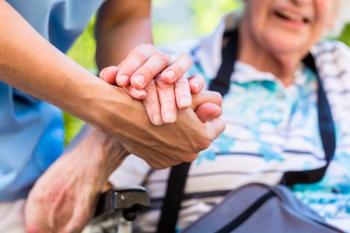
Low Handgrip Strength, Obesity Associated With Increased Risk of CKD in Women
Post-menopausal women who had dynapenic-abdominal obesity, determined by hand-grip strength and waist circumference, had a higher risk of chronic kidney disease (CKD) compared with controls.
A study published in
The researchers used a nationwide population-based survey, the Korea National Health and Nutrition Examination Survey, for the data in this study. The survey was conducted from 2016 to 2019 and included a health interview, a health examination, and a nutrition survey.
Women were considered postmenopausal if they had a cessation in menstruation for more than or equal to a year and it was reported in the questionnaire. Participants were excluded if they had missing data for variables including dynapenic-abdominal obesity, estimated glomerular filtration rate (eGFR), and other covariates. Participants were also excluded if they did not have fasting blood levels or implausible energy intake of less than 500 or more than 4000 kcal per day.
There were 4525 postmenopausal women included in the study and they separated into 4 groups: healthy controls, dynapenic, abdominal obese, and dynapenic-abdominal obese. These were determined by handgrip strength and waist circumference of each participant. Blood pressure, eGFR, and smoking status were also assessed.
The mean (SE) age of all participants was 63.9 (0.2) years and the mean age of menopause was 50.1 (0.1). The prevalence of CKD was 5.0% and the mean eGFR level was 87.4 (0.3). There were 466 (9.4%) participants who had dynapenia, 1337 (29.0%) who had abdominal obesity, and 387 (7.6%) who had dynapenic-abdominal obesity.
Women with dynapenic-abdominal obesity were significantly older and lower eGFR levels compared with other groups. This group also had a significant amount of participants with diabetes (36.1%), dyslipidemia (60.7%) and hypertension (79.9%).
Participants with dynapenic-abdominal obesity had lower mean (SE) eGFR levels (78.2 [1.2]) compared with dynapenic (83.9 [0.9], abdominal obese (85.9 [0.5]), and normal (90.1 [0.3]) groups. A linear regression model demonstrated that eGFR levels were associated with presence of dynapenia and abdominal obesity. CKD was prevealent in 15.5%, 7.8%, 6.2%, and 2.4% of the dynapenic-abdominal obese, dynapenic, abdominal obese, and control groups respectively.
Logistic regression analyses found that the ORs of CKD in the dynapenic, abdominal obese, and dynapenic-abdominal obese groups were 3.47 (95% CI, 2.22-5.42), 2.70 (95% CI, 1.90-3.85), and 7.49 (95% CI, 4.89-11.49) respectively. The ORs for CKD remained significant in abdominal obese and dynapenic-abdominal obese groups after adjusting for variables, with the risk of CKD higher than the normal group in the abdominal obese group (OR, 1.54; 95% CI, 1.07-2.22) and the dynapenic-abdominal obese group (OR, 1.82; 95% CI, 1.19-2.79).
There was no significant association between dynapenia and CKD after adjusting for confounding variables (OR, 1.05; 95% CI, 0.65-1.67).
There were some limitations to this study. The cross-sectional design of the study could not determine the cause-and-effect relationships between dynapenic-abdominal obesity and CKD. The researchers used hand grip strength and waist circumference as determinant factors for CKD in this study as they were superior to muscle mass and BMI. Selection bias could not be ruled out due to the exclusion of those with missing data.
The researchers concluded that there was an association of dynapenic-abdominal obesity, determined by hand grip strength and abdominal obesity, with CKD in women post-menopause.
Reference
Choi Y, Cho J, Kim J, et al. Dynapenic-abdominal obesity as an independent risk factor for chronic kidney disease in postmenopausal women: a population-based cohort study. Menopause. 2022;22(9):1040-1046. doi:10.1097/GME.0000000000002032
Newsletter
Stay ahead of policy, cost, and value—subscribe to AJMC for expert insights at the intersection of clinical care and health economics.

















































